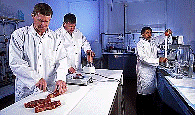United States Department of Agriculture: Agricultural Research Service, Lincoln, Nebraska

Roman L. Hruska U.S. Meat Animal Research Center: Reports
Date of this Version
1993
Document Type
Article
Citation
Published in Beef Research Program Progress Report, No. 4, Part 2 (May 1993)
Abstract
Decreasing the amount of fat in beef decreases loss due to trim and the number of calories in a serving. Differences in fat content of cattle are caused by differences in genotype, gender, chemical agents and energy intake relative to functional requirements. An increase in energy intake increases both fat content and body weight. Based on this fact, differences in energy intake cause an association between fat content and body weight. This fact has led some scientists to suggest the hypothesis that fat content of animals of similar genotype and gender can be predicted from body weight even if there are differences in energy intake. In order for this hypothesis to be true, rate of gain for fat must be proportional to rate of gain for body weight. Previous research has demonstrated that this is not the case. Increasing energy intake decreases the days required to reach a constant slaughter weight and increases the fat content of cattle slaughtered at a constant weight. Hence, increased fat content is associated with fewer days required to reach the same final weight when genetically similar cattle consume different amounts of energy. The contents of the gastrointestinal tract (gut fill) influences body weight. Gut fill varies among measurements of different animals or among repeated measurements of the same animal. For this reason, carcass weight is a better indicator of an animal's "true weight" than body weight. The objectives of this st4dy were to estimate differences in fat content caused by variation in energy intake and to determine the extent to which these differences are associated with carcass weight or days to slaughter.

